| Area: Zaimokuza (材木座) |
The "zaimoku" in the area named Zaimokuza means "lumber," and the "za" generally means a kind of trade organization of merchants and artisans who did business under the patronage of the bakufu (幕府), large shrines, and temples in the Kamakura (1185/92-1333) and Muromachi periods (1335-1573).
In the Kamakura period, Zaimokuza was a thriving port of call for trade. In time, the port of Wakaejima (和賀江島) was constructed to cope with the expanding commerce.
Following expansion, the area became a trading center for lumber, and many lumber merchants settled here.
The lumber guilds were supposedly formed around the late Kamakura to early Muromachi periods.
Even as early as the time when Minamoto no Yoritomo (源頼朝, 1147-99) had a new shrine, Tsurugaoka Hachimangu, built on its present location, many laborers hauled carts loaded with lumber from Wakaejima Port, loudly chanting kiyariondo (木遣り音頭, a lumber-carriers'chant), on their way to Tsurugaoka Hachimangu Shrine. This chant has been handed down as tenno'uta (天王謡) in the Zaimokuza area.
|
Yui Wakamiya Shrine, a. k. a. Moto Hachiman (由比若宮 又は 元八幡) |
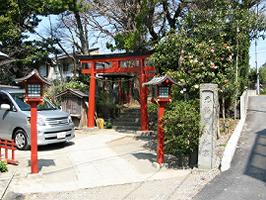
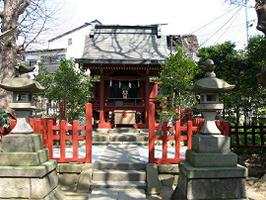
Location: 0.8 kilometers south of JR Kamakura Station
Grounds and Structure: At the corner of the lane stands a small stone marker inscribed with the characters "元鶴岡八幡宮," Moto Tsurugaoka Hachimangu. The shrine is tucked away from the main road and its vermilion structure is simple and modest considering its history.
The shrine, in the nagare-zukuri style (流造), has a structure whose front roof extends in a gentle curve into a projecting eave over the entrance.
History: The shrine is attributed to Minamoto no Yoriyoshi (源頼義, 988-1075). In 1063, during a stay in Kamakura on his way back from a battlefield in Tohoku region against the Abe (安倍), called Zenkunen no Eki (前九年の役, 1051-62), the Earlier Nine Years' War, he had "part of" the deity from Iwashimizu Hachimangu Shrine (岩清水八幡宮) in Kyoto transferred here and had a shrine built so that his prayers might be answered. At Iwashimizu Hachiman prior to departure for the battlefield, he had prayed for victory against the Abe in Tohoku. As Hachiman was a tutelary deity of the Minamoto clan (源), Kamakura already had something to do with the Minamoto in his time.
Furthermore, Yoriyoshi's son, Minamoto no Yoshiie (源義家, 1039-1106), also had deep faith in this deity: he often came to pray for victory and had the shrine repaired.
When Minamoto no Yoritomo established his government, he transferred the shrine from this place to its present site at Tsurugaoka Hachimangu in 1180. Since then, the shrine here has come to be popularly called Moto Hachiman, "Original Hachiman." The formal name, however, is Yui Wakamiya Shrine.
| Keiunji (啓運寺) |
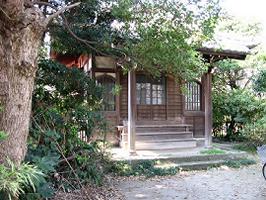
Full name: Shokosan Keiunji (松光山 啓運寺)
Denomination: Nichiren sect (日蓮宗)
Location: 0.9 kilometers south of JR Kamakura Station
History: The founding priest was Keiun Nitcho (啓運日澄). Said to have been not only virtuous but also learned, he studied the Hokekyo Sutra (法華経) and wrote a 55-volume work, Keiunsho (啓運抄).
Grounds: In the center is the Main Hall built in 1933, which holds a mandala (曼荼羅), the main object of worship, and a statue, made between 1818-30, of Nichiren (日蓮, 1222-82) reading a sutra. Another statue in the Main Hall is Funamori Inari (船守稲荷), worshiped by sailors and fishermen for safe seas.
To the right of the Main Hall is a one-meter-tall stone stupa said to have been built in Kamakura period.
Story: In the middle of the Meiji period (1867-1912), Kuroda Seiki (黒田清輝, 1866-1924), an artist, used the Main Hall as a studio. The paintings he created here include one of Nichiren street preaching, considered one of Kuroda's masterpieces. He is said to have introduced impressionism into Japan.
| Myochoji Temple (妙長寺) |
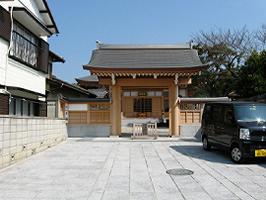
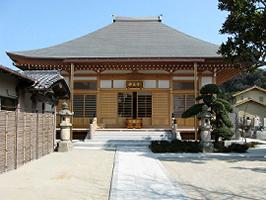
Full name:Kaichosan Myochoji (海潮山 妙長寺)
Denomination:Nichiren sect (日蓮宗)
Location: Diagonally opposite Keiunji.
History: The story of Myochoji had its beginning when Nichijitsu (日実), a disciple of Nichiren, built a temple at Numaura (沼浦) in Zaimokuza, from where Nichiren departed for exile in Izu. Washed away by a tsunami, it was reconstructed here in 1681.
Grounds In front of the Sammon Gate (山門) is a stone marker inscribed with the characters "伊豆法難 船出霊跡," indicating the sacred site where, in 1261, Nichiren was forced to depart for exile in Izu, later referred to as the Izu Persecution (伊豆法難).
To the right of the gate stands a statue of Nichiren completed in 1988, and behind the gate nine bronze wheels sit on a stone.
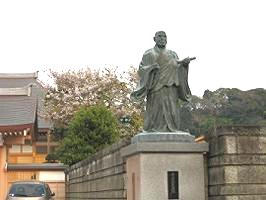
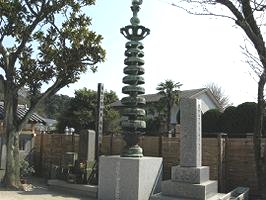
The Main Hall houses many statues: Nichiren, Nichiro (日朗), Nichijitsu, sambo-soshi (三宝祖師), Shi Bosatsu (四菩薩), Shichimen Tennyo (七面天女), and Sammen Daikokuten (三面大黒天).
| Midarebashi Bridge (乱橋) |
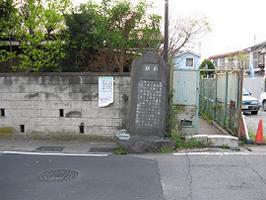
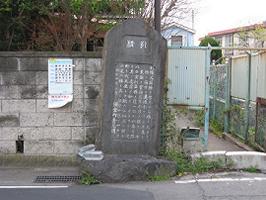
When you walk toward the beach from Myochoji, you will soon see a bridge. It is so short that it can easily be overlooked, but was once counted among the ten major bridges in old Kamakura.
The name of the bridge, "midare," means "disorder." When the forces of Nitta Yoshisada (新田義貞, 1301-38) attacked Kamakura in 1333, a battle between his forces and those of the bakufu took place near the bridge. The bakufu's forces were soon defeated and thrown into disorder, an event that gave rise to the name of the bridge.
In spite of this long-told story, scholars point out that the name already appeared in an official records of 1222.
| Kofukuji Temple (向福寺) |
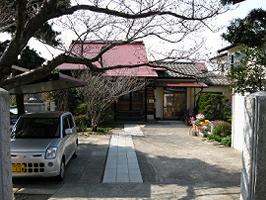
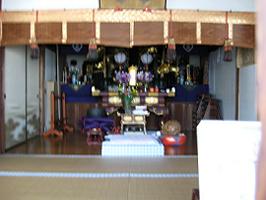
Full name: Enryusan Kofukuji (円竜山 向福寺)
Denomination:Ji sect (時宗)
Location: 1.1 kilometers south of JR Kamakura Station
History: The founder was Ikko Shunjo (一向俊聖) and the temple was built around 1282. Ikko was a wandering priest like Ippen (一遍, 1239-89) who founded the Ji sect in the Kamakura period.
Grounds The Main Hall houses statues of Amida-sanzon (阿弥陀三尊), which consists of three Buddhist images, Amida Nyorai (阿弥陀如来), Kannon Bosatsu (観音菩薩), and Seishi Bosatsu (勢至菩薩)), and Sho Kannon (聖観音).
| Jissoji Temple (実相寺) |
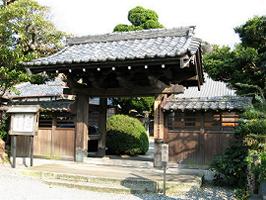
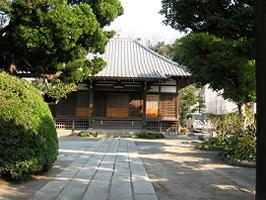
Full name: Koenzan Jissoji (弘延山 実相寺)
Denomination: Nichiren sect
Location: 1.2 kilometers south of JR Kamakura Station
History: The grounds are said to have been the former site of the residence of Kudo Suketsune (工藤祐経, ?-1193), a vassal of Minamoto no Yoritomo. He was killed in return by the Soga brothers (曽我兄弟) for having murdered their father.
In the late thirteenth century, a priest, Nissho (日昭), who was a son of a daughter of Suketsune, built Hokkedo Hall (法華堂). Nissho was Nichiren's immediate disciple, and after Nichiren's death, he became one of the senior priests in the sect.
After Hokkedo Hall was transferred to Mishima (三島, in present-day Shizuoka Prefecture), the present temple, Jissoji, was built in 1621 by Nichijun (日潤).
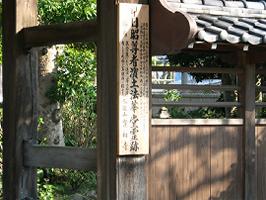
Grounds Upon passing through the gate, you will see the Main Hall ahead. A pair of elephant carvings is visible under the eaves.
The principal image in the Main Hall is itto ryoson shibosatsu (一塔両尊四菩薩). Itto is a monument with the inscription 南無妙法蓮華経 (Namu-Myoho-Rengekyo). Ryoson means Shaka Nyorai (釈迦如来) and Taho Nyorai (多宝如来), and shibosatsu are four Bodhisattvas.
The temple is small and quiet. On the hillside to the right of the Main Hall is Nissho's tomb.
| Gosho Jinja Shrine (五所神社) |
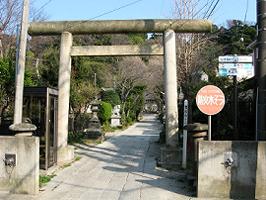
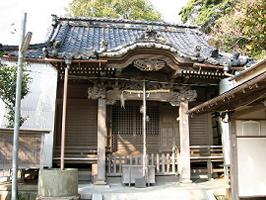
Location: 1.1 kilometers south of JR Kamakura Station.
History: The shrine was built in 1908 to combine eight shrines in the area: Yagumo (八雲), Mishima (三島), Suwa (諏訪), Kompira (金毘羅), and Mirumeyasaka (視女八坂). The enshrined deities are Oyamatsumi no Mikoto (大山祗命), Amaterasu Omikami (天照大(御)神), Susanoo no Mikoto (素盞鳴命), Takeminakata no Mikoto (建御名方命), and Sutoku-in no Mitama (崇徳院霊,1119-64).
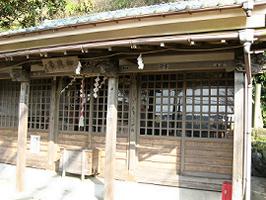
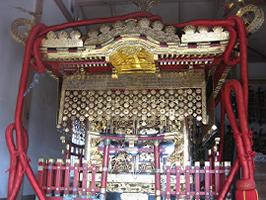
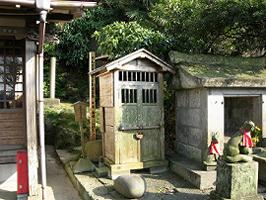
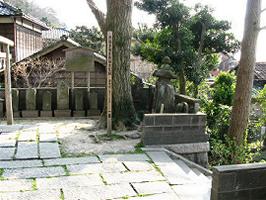
Grounds: The shrine is the tutelary deity of Zaimokuza.
Beyond the stone torii, a 50-meter approach is lined with stone lanterns and a pair of Korean dogs. At the top of the stone steps are a repository for three portable shrines, mikoshi (神輿), in front and the Main Hall to the left.
On the second Sunday of each June, a lively festival is held, attended by many local people. The mikoshi is thought to be very old since the repository contains a plaque marked 寛永十九年 (corresponding to 1642).
A small structure to the right holds a neatly preserved itabi (板碑), a stone tablet, inscribed with an era name 弘長二年 (corresponding to 1262). The Sanskrit character on the surface symbolizes Fudo Myoo (不動明王). This monument is very precious and has been designated a National Important Work of Art.
Close by are 13 stone monuments dedicated to the koshin (庚申) cult. An explanation is written on the nearby signboard.
There is also a large stone dedicated to Ishigami Inari Daimyojin (石上稲荷大明神). The signboard gives an explanation about tenno'uta, chants sung at a festival.
| Raikoji Temple (来迎寺) |
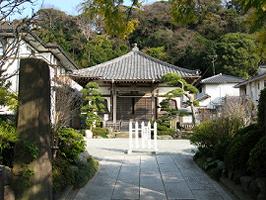
Full name:Zuigazan Raikoji (随我山 来迎寺)
Denomination: Ji sect
Location: 1.1 kilometers south of JR Kamakura Station
History: The temple, originally called Nojoji (能蔵寺), was built in 1194 for the repose of the soul of Miura Yoshiaki (三浦義明, 1092-1180). He had taken up arms to support Yoritomo's campaign against the Taira, and despite his 89 years of age, fought at the forefront.
In the first stage of the campaign, which saw Yoritomo's defeat, Yoshiaki sacrificed himself in the battle at Kinugasa Castle (衣笠城), encouraging his followers to block an attack by the Taira followers.
Later, On'a (音阿), a priest, converted the temple to the Ji sect and renamed it Raikoji.
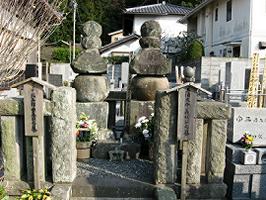
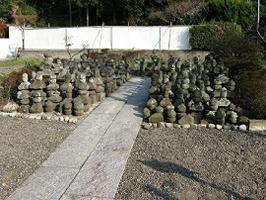
Grounds: In the Main Hall are statues of Amida-sanzon (a set of three images: Amida Nyorai, Kannon Bosatsu, and Seishi Bosatsu), and Sho Kannon, popularly called Kosodate Kannon (子育て観音), "Child-rearing Kannon."
The main image is said to have been the guardian deity of Miura Yoshiaki.
Miura Yoshiaki's gorinto-type stupa (五輪塔) is in the cemetery next to the Main Hall along with a two-meter-high same type stupa allegedly dedicated to Tatara Saburo Shigeharu (多々良三郎重春), who died in this vicinity at the age of 17 while fighting against the army of Hatakeyama Shigetada (畠山重忠, 1164-1205).
He had been on his way back to the Miura Peninsula from Mt. Ishibashi (石橋山), where the army of Yoritomo (Tatara joined it) engaged in its first battle against the Taira and was defeated. In those days, the Hatakeyama still sided with the Taira camp, but later joined Yoritomo's side.
More than one hundred small gorinto-type stupas, said for the Yoshiaki's followers, within the cemetery indicate that the temple has been a resting place not only for famous warriors but for the unnamed as well.
| Kuhonji Temple(九品寺) |
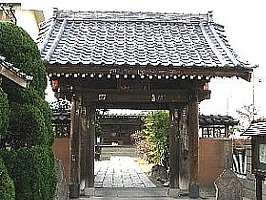
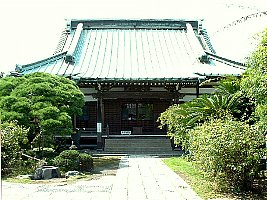
Full name:Dairisan Kuhonji(内裏山 九品寺)
Denomination:Shingon sect (真言宗)
Location: 1.3 kilometers south of JR Kamakura Station
History: The founding is attributed to Nitta Yoshisada. In 1333, when he attacked the Hojo (北条) government in Kamakura, he pitched his camp here. After destroying the Hojo, in 1336 he built the temple in their memory, inviting, from Kyoto, Fuko Junsai (風航順西), a priest, whom Yoshisada revered deeply.
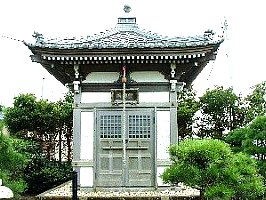
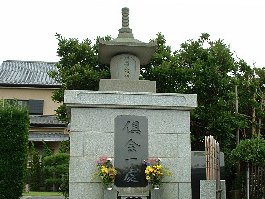
Grounds: To the right of the gate stand two stone monuments: one bears the inscription 鎌倉三十三観音霊場十六番札所, the 16th of 33 pilgrimages of Kannon in Kamakura, and 二十一ケ所弘法大師, one of 21 pilgrimages associated with Kobo Daishi (弘法大師, 774-835).
Beyond the Sanmon gate that has "Dairisan" written on its wooden plaque, the Main Hall stands in the neatly arranged garden. Under its eaves is a carving of a dragon in the center of the beam. In front of the Hall is a pair of large, bronze rain barrels in the shape of lotus leaves.
Yoshisada's contributions are still visible: the characters 内裏山 (Dairisan) on the plaque under the roof of the gate and 九品寺 (Kuhonji) on the plaque under the eaves of the Main Hall, although replicas, are in the hand of Yoshisada himself, the originals being housed in the Main Hall for preservation.
The main image is a fourteenth century standing statue of Amida Nyorai with crystal eyes done in Sung-Yuan style (宋元風), a type of statue rare in Kamakura. A stone statue (now entrusted to the Kamakura Kokuhokan) of a seated Yakushi Nyorai (薬師如来) with the inscription 永仁四年 (corresponding to 1296) is well known for its well-balanced figure and is designated an Important Cultural Property by Kanagawa Prefecture.
| Fudarakuji Temple (補陀洛寺) |
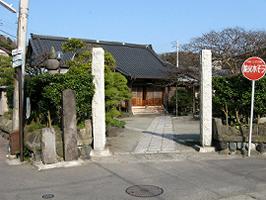
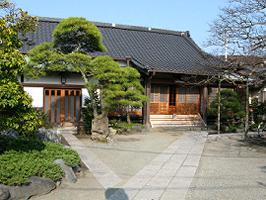
Full name:Nankozan Fudarakuji (南向山 補陀洛寺)
Denomination: Shingon sect (真言宗)
Location: 1.4 kilometers south of JR Kamakura Station History: The temple, said to have been built in 1181 at the request of Yoritomo, with Mongaku (文覚,1139-1203) as the founding priest, belongs to the Shingon sect.
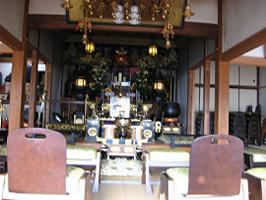
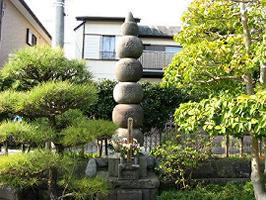
Grounds: To the left in front of the gate is a stone marker which says 源頼朝公御祈願所 補陀洛寺, "Fudarakuji where Minamoto no Yoritomo Would Come to Pray." Within the modest grounds you will see the Main Hall, the priest's living quarters, and a tall crape myrtle (sarusuberi, さるすべり) extending its branches over the grounds.
Though the temple looks modest at first sight, it possesses a number of statues, including Juichimen Kannon (十一面観音), or Eleven-faced Kannon, the principal image.
The statue of Fudo Myoo in the Main Hall is said to have been made in the late Heian period (794-1185/92) by Chisho (智証) to pray for the destruction of the Taira.
The statue of Yakushi Nyorai is attributed to Gyoki (行基, 668-749). The pair of statues of Nikko Bosatsu (日光菩薩) and Gakko Bosatsu (月光菩薩) were reputedly made by Unkei (運慶, ?-1223) and the statue of Jizo is said to have been the work of Kobo Daishi.
The temple also has a mortuary tablet written by Mongaku. Other works are a wooden statue of Yoritomo allegedly made by Yoritomo himself, and a 30-centimeter-tall wooden statue of a naked Mongaku depicting him undergoing the religious discipline of standing under a waterfall at Nachi (那智), carved by himself during this occasion.
Among other treasures is a red flag said to have once belonged to the Taira. Taira no Munemori (平宗盛, 1147-85), General of the Taira, had it with him when the Taira perished at Dannoura (壇ノ浦) in 1185. It was brought to Yoritomo in Kamakura, and he in turn made an offering of it to this temple. The characters, 九万八千軍神, literally, "Ninety-eight Thousand Martial Deities," are written on it. None of these treasures, however, is open to the public.